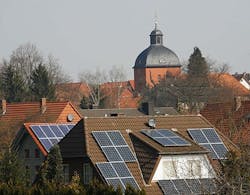Palladium diselenide could be next high-efficiency photovoltaic material for spacecraft use
Researchers at Siberian Federal University (Krasnoyarsk, Russia) and the Royal Institute of Technology (Stockholm, Sweden) have discovered new properties of palladium diselenide (PdSe2) that could lead to high-performance solar cells made from the material.1
PdSe2, a transition metal dichalcogenide, is a promising material whose properties have not yet been fully studied. For example, it was reported that its 2D form can be effective in photocatalysis (the process of splitting water into hydrogen and oxygen via sunlight), which can be used to produce ecological fuel. Researchers have recently learned how to synthesize single- and double-layered versions of PdSe2, but the advantages and weaknesses of these materials remained unknown until recently.
The researchers used high-precision calculations for the first time to study the electronic and optical properties of single- and two-layer material based on PdSe2 in detail—which, as it turns out, can absorb solar energy more efficiently than the silicon used in conventional photovoltaics, say the researchers. The fundamental band gaps for single- and double-layered PdSe2 are 2.55 and 1.89 eV, respectively; these values fall at opposite end of the visible spectrum, showing promise for solar cells. The experimental optical band gap for the single-layer variety of PdSe2 is 1.32 eV; it's value is lower due to Se vacancies.
"The material demonstrates higher conversion rates of solar energy into electrical energy due to a wider spectrum of energy absorption compared to silicon-based elements used today as semiconductors, and therefore can significantly increase the efficiency of solar cells," says Artem Kuklin, one of the researchers from Siberian Federal University. "PdSe2 can be used as an independent material for solar-cell elements in the construction of spacecraft and artificial Earth satellites, since the material efficiency in most cases justifies the costs in the space industry."
To carry out high-precision calculations of material properties, scientists used the Akademik Matrosov supercomputer, located at the Matrosov Institute for System Dynamics and Control Theory, part of the Siberian Branch of the Russian Academy of Sciences (RAS) in Novosibirsk.
The researchers plan to continue their work exploring the effect of defects on the material's properties and the probability of their formation. Having learned to manage defects, scientists will be able to create PdSe2 with predictable characteristics.
Source: https://www.eurekalert.org/pub_releases/2019-07/sfu-ss073019.php
REFERENCE:
1. Artem V. Kuklin and Hans Ågren, Physical Review B (2019); https://link.aps.org/doi/10.1103/PhysRevB.99.245114.
About the Author
John Wallace
Senior Technical Editor (1998-2022)
John Wallace was with Laser Focus World for nearly 25 years, retiring in late June 2022. He obtained a bachelor's degree in mechanical engineering and physics at Rutgers University and a master's in optical engineering at the University of Rochester. Before becoming an editor, John worked as an engineer at RCA, Exxon, Eastman Kodak, and GCA Corporation.

